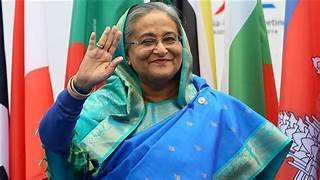Sheikh Hasina, a name synonymous with Bangladesh’s modern political landscape, has seen a dramatic rise and fall that reflects the turbulent nature of the country’s political scene. This blog delves into the complex journey of Sheikh Hasina, from her emergence as a powerful leader to her subsequent political downfall. Understanding her trajectory offers insights into both her achievements and the challenges that led to her ousting.
The Rise of Sheikh Hasina
Initially, Sheikh Hasina emerged as a formidable political force in Bangladesh. Her rise began in the late 1970s when she took over the leadership of the Awami League (AL), a major political party in the country. Her entry into politics was significantly influenced by the tragic assassination of her father, Sheikh Mujibur Rahman, the founding father of Bangladesh. Following this personal loss, she was determined to continue his legacy and advocate for the development and stability of Bangladesh.
Consequently, Sheikh Hasina’s leadership was marked by significant political achievements. Her tenure as Prime Minister, which began in 1996, was characterized by various reforms aimed at improving infrastructure, education, and healthcare. Moreover, her administration focused on economic growth, which led to impressive GDP growth rates and a reduction in poverty levels. Her policies also garnered support from international organizations and investors, further solidifying her position as a key player in Bangladesh’s development.
Furthermore, Sheikh Hasina’s political acumen and her ability to navigate complex political dynamics played a crucial role in her rise. She managed to consolidate power through strategic alliances and by addressing key issues facing the nation. Thus, her leadership was widely seen as a beacon of hope for many Bangladeshis.
The Challenges and Controversies
However, the path of Sheikh Hasina’s political journey was not devoid of challenges. For instance, her tenure faced accusations of corruption and authoritarianism. Critics argued that her government increasingly concentrated power in the hands of the ruling party, undermining democratic processes and institutions. In addition, there were concerns about human rights abuses and the suppression of dissent.
In particular, allegations of electoral fraud and unfair practices marred the 2014 general elections. The opposition, led by the Bangladesh Nationalist Party (BNP), accused her administration of manipulating the election process to secure a victory. Subsequently, this led to widespread protests and a tense political climate.
Moreover, Sheikh Hasina’s handling of the Rohingya crisis also drew criticism. Although her government provided refuge to the displaced Rohingya people from Myanmar, there were concerns about the adequacy of the response and the long-term implications for Bangladesh’s resources and security.
The Downfall
The political landscape began to shift significantly in the late 2010s and early 2020s. As a result, Sheikh Hasina faced mounting opposition and increasing discontent among the populace. Additionally, the economic growth that had initially bolstered her position started to show signs of stagnation, exacerbated by global economic challenges and domestic issues.
Moreover, accusations of corruption and mismanagement continued to haunt her administration. The political opposition, capitalizing on these grievances, gained traction and began challenging her dominance. Consequently, this led to a series of protests and political unrest that further destabilized her position.
Ultimately, the tipping point came with a combination of electoral setbacks and widespread public disillusionment. The 2024 general elections, marred by allegations of irregularities and violence, were a significant blow to her political standing. Thus, Sheikh Hasina’s grip on power weakened, culminating in her ousting from the position of Prime Minister.
The Aftermath and Legacy
Following her ousting, Sheikh Hasina’s legacy remains a topic of debate. On one hand, she is credited with significant achievements in economic development and infrastructure. On the other hand, her tenure is also associated with controversies related to governance and human rights. Therefore, her legacy is viewed through a lens of both admiration and criticism.
In addition, the political landscape of Bangladesh continues to evolve as new leaders and parties emerge. Therefore, the long-term impact of Sheikh Hasina’s rise and fall will likely be studied and analyzed for years to come.
Conclusion
In conclusion, the rise and fall of Sheikh Hasina is a testament to the volatile nature of political leadership. While her tenure was marked by notable achievements, it was also fraught with challenges and controversies that eventually led to her political downfall. Thus, her story provides valuable lessons on leadership, governance, and the complexities of managing a nation’s political landscape.
As Bangladesh continues to navigate its political future, the experiences of Sheikh Hasina offer both cautionary tales and inspirational elements for future leaders and policymakers.


